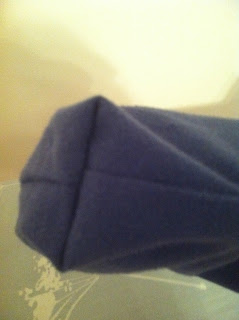Okay... you got me! I couldn't wait! I'm so excited about this project, though!!!!! Since it's a new crochet technique I simply couldn't wait to finish it and post!
As a reminder, Tunisian crochet works in tiers and picks up stitches at the vertical bar rather than the top of the stitch (above). I really enjoyed working this particular project because of the tiers.
These two are pictures of the project where (above) I was working the end of the tiers and preparing for the finishing border and (below) I finished the scarf with finishing border. (Yes, it is called "finishing border" in the book! I was totally not being redundant!) I figured these two pictures would give you a good feel for what the project looks like. I was kind of sad when I realized that I switched the directions of the tiers at one point, but oh well, it's finished!! And no one would have known if I hadn't said anything. The thing is there are two sides to Tunisian crochet... one side is considered the "front" and has the vertical bars while the other side, the "back," looks all bunched up and stuff. In the picture above, the green squares are showing their "front" side and the pink squares are showing their "back" side. I did this on purpose because I think both sides look nice. I also like the effect of the front and back sides together. Besides, it's a scarf... there is no true "front" and "back" to a scarf! Is there... ? I didn't think so!
At the end of my little scarf project I had a few leftovers.... I'm wondering what to do with them... I'll figure something out, right? Yay! Thanks for the confidence!
So... I would post the pattern. Instead I will give you the book name and page number and stuff.
Author: Sheryl Thies
Title: Get Hooked on Tunisian Crochet: Learn How With 13 Projects
Copywrite: 2011 - by Sheryl Thies
Publishers: Martingale & Company (registered)
19021 120th Ave. NE, Suite 102
Bothell, WA 98011-9511 USA
www.martingale-pub.com
Printed: in China
Page: 46-49 (with references to other pages of the book)
Skill level: Intermediate
Since I did not use the same type of yarn and size of hooks it turned out to be a slightly different project that what the book gives, but I expected and wanted this for my project. The book pattern is given for a shawl, but I created a scarf. For more information on gaging, sizing, and creating specific projects to size, comment or e-mail me!
Blessings!
P.S. Stay tuned for more yarn projects! I have a crochet blanket (I don't know if I should call it a baby blanket or an afghan at this point), a poncho, and a couple of crochet bags coming up!! Plus who knows what I'll be inspired to sew!!































